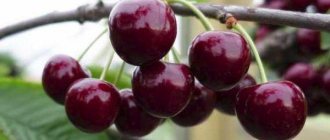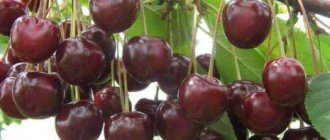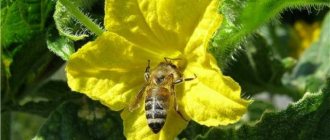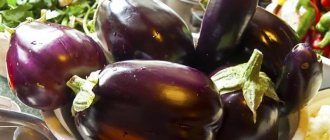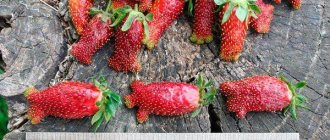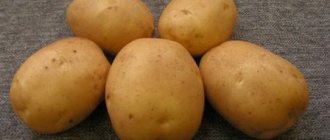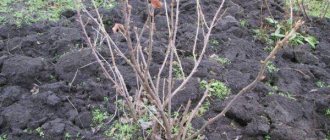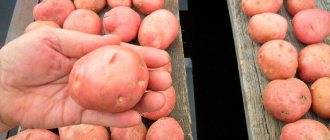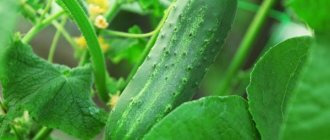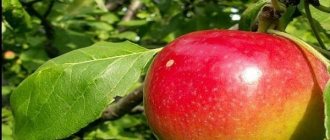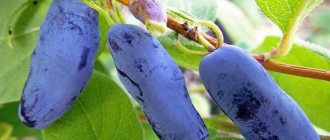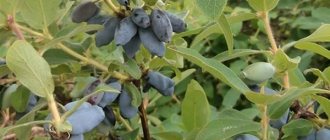Cherry trees have been grown in gardens for centuries. Currently, thanks to the efforts of breeders, more than 190 varieties of these stone fruit trees have been bred for cultivation, which differ in appearance, characteristics and taste of the berries. All these cherry trees are divided into two varieties: tree and bush.
Bush varieties are low, frost-resistant, easy to prune and harvest, and their average lifespan is up to 18 years.
Tree varieties are fruit trees reaching a height of more than 2.5 m. Their lifespan is more than 25 years, but with low resistance to cold. Shubinka cherry also belongs to this type; the main advantages and characteristics will be discussed below.
Description and characteristics of the variety
Cherries can be bush or tree-like. Shubinka is a tree-like plant. It begins to bear fruit in the third or fourth year after planting and the yield is stable every year. Has good shoot recovery ability. Therefore, gardeners, by making the necessary pruning at the right time, extend the life of trees. Plants also form root shoots, which are recommended to be removed promptly and thoroughly. True, if you want, you can grow a tree from the shoots. It will be more durable than a grafted one, but will begin to bear fruit a year later. More detailed characteristics of the tree and fruit can be found below.
Tree
The trees are vigorous, undemanding to soil and climate. They can be 3–4 meters high. The crown is pyramidal, not thickened, spreading. At the base of the trunk the branches are dark, and then their color gradually turns brownish-green. The leaves are green, oval, alternate, pointed towards the apex. The edges are slightly jagged, medium in size. The lower part of the leaf blade is slightly lighter than the upper. The petiole is medium.
The flowers are five-lobed, white, collected in inflorescences of 5–6 pieces. The petals are slightly forked and pressed loosely against each other.
Cherry can grow as a small shrub up to 1.5 meters in height. They are long-lived. For example, steppe cherry bushes grew in the Vladimir region in one place for a little over 300 years.
Fruit
The fruits are small, weighing from 2 to 2.5 grams. In the ripe stage they are dark red. The shape of the berries is flat-round. The side seam is slightly flattened. The skin is thin and shiny. The pulp is juicy and has medium density. Quite loose. The funnel is not deep. The peduncle is long or medium, thin. Attached to the cherry tightly. The sugar content in the juice is low, so the cherries are sour with little tartness. Although the berries are visualized beautiful. In addition, they are aromatic and quite juicy.
Cherry fruits contain coumarins (hydroxycoumarins predominate). These substances prevent the formation of blood clots.
Peculiarities
Shubinka cherry is an undemanding plant. It can grow on any soil. Even on sandy and rocky ones. But it will significantly increase the yield in wet and fertile areas. Because it is winter-hardy, some gardeners plant this tree in their garden, not paying attention to the taste of the fruit, which, due to the increased acidity of the juice, can only be processed and not consumed fresh. In addition, Shubinka ripens late, and when everyone has forgotten the taste of the berries, small red fruits appear on the trees, from which you can make compotes, preserves, and jams. More information about the characteristics of the Shubinka cherry variety can be found below.
Winter hardiness
The frost resistance of the variety is high. Trees resist early autumn and late spring frosts. They can easily tolerate thirty-degree frosts. True, this applies more to perennial plants. In young trees, when the temperature drops significantly, the buds may freeze, as well as that part of the root system that is located in the top layer of soil. Therefore, seedlings need additional protection in winter.
Disease resistance
The Shubinka variety can resist monilial burn, but is often affected by coccomycosis. If you do not take preventive measures to protect plants, then in the middle of summer the trees will lose all their leaves and you can’t expect a harvest for the next year. Also, stone fruit gums may appear on branches for various reasons. Read how to treat cherry moniliosis in this article.
Pollinators
Shubinka cherry is a partially self-fertile plant. That is, if another variety of cherry or sweet cherry does not grow near it, then only 30% of the number of flowers will appear. The best pollinators can be varieties such as Lyubskaya, Anadolskaya, Kharitonovskaya, Griot Podbelsky, Shchedraya, Saika, Griot Ostheimsky.
Ripening time and yield
Late ripening variety. That is, the harvest can be harvested from the beginning of August to the middle, or even the end of September. You don’t have to rush to pick the cherries, since the stalks are securely attached to the berries, and they don’t fall off. This material will tell you how to graft cherries onto cherries.
Productivity is 5-10 tons per hectare. And in terms of wood – from 17 to 28 kilograms. The number of berries depends on proper and timely tree care.
The Lyubskaya variety, for comparison, can produce about 80 kg of berries per tree.
Transportability
The stalk is well attached to the berry, so when harvesting the cherries can be removed along with them. And this will prevent them from expiring juice during transportation.
The pulp is not loose. Therefore, if you pack cherries in a small layer in a box, you can transport them over long distances.
Summary
In general, if the gardener maintains all the specified conditions, then there is a high probability of getting a very decent and tasty harvest. The most important thing is to simply take into account the needs of the autumn cherry variety Virovskaya, its characteristic features and properties. I would like to list some of the advantages and disadvantages of the variety.
The advantages of felt cherries of the autumn Virovskaya variety include:
- large-fruited harvest
- excellent taste and tasting characteristics of fruits
- high level of productivity (if all conditions are met, the harvest will be annual, abundant and stable)
- high winter hardiness - but this will depend on climatic indicators.
Disadvantages of the variety:
gradual shrinking of the autumn Virovskaya cherry variety in the event that the fruits have formed in large quantities. But this point can be corrected by the gardener himself if he promptly carries out regulatory pruning of the shoots on which the bulk of the autumn Virovskaya felt cherry harvest is formed.
Growing
Basic principles of growing Shubinskaya cherries:
- The better the sun illuminates the area where the cherry is planted, the sweeter its fruits will be and the higher the yield;
- Also, when planting, you need to take into account the fact that the cherry is a spreading tree. Therefore, the minimum distance between plantings should be 3 meters;
- No matter how frost-resistant this crop is, it is better to plant seedlings in places protected from northern winds.
One of the main conditions for good development of seedlings, and subsequently high yields, is the correct choice of seedlings. They must be purchased only from fruit nurseries or trusted sellers. Planting material must meet the necessary requirements.
Climatic conditions
In the southern regions of the country, yields will be lower than in the central regions. Since this variety was acclimatized in the temperate climatic zone of broad-leaved forests and the steppe climate is not entirely suitable for it. Therefore, Shubinka will grow and bear fruit better in the central regions of the country, but not in the northern or southern regions.
The soil
Shubinka cherry can grow on any soil, but when there is no choice, but you have to plant it in clay or sandy soil, it can develop and bear fruit only if the seedling is placed in a large planting pit with a full range of organic and mineral fertilizers , laid on its bottom. Cherry, like other plants, bears fruit better on fertile soils with neutral acid-base values. Read what you can plant next to cherries here.
When planting a seedling, you should also consider the depth of groundwater. Therefore, it is better to plant stone fruit trees on small hills, but not on lowlands.
Landing
Standard Shubinka cherry planting:
- Pour organic fertilizer into the planting hole. It could be manure, humus. If there is no organic matter, then use mineral ones, having first thoroughly mixed them with the soil: potassium salt (11 g), superphosphate (40 g), ammonium nitrate (20 g) per square meter of area;
- Drive a wooden or bamboo stake 1.2 meters high into the bottom of the hole;
- Place the seedling and straighten its root system. Make sure that the root collar remains at ground level after planting;
- Sprinkle the hole with soil and compact it thoroughly;
- Water, mulch, tie the seedling to a stake with twine.
The twine should not tightly cover the stem. Therefore, it is better to use eight in this case.
About diseases and pests
Cherry Shubinka: description of the variety
In general, Shubinka cherry is unpretentious and winter-hardy, however, it is often attacked by coccomycosis and rarely by shoot moths.
With coccomycosis, a fungal disease, cherry leaves are damaged. It is important not to start the disease so that the fruits do not suffer. The disease manifests itself in the appearance of small reddish dots on the upper part of the leaves. If the disease is not dealt with, the lower surface of the leaves will be completely covered with fungal spores, and everything ends with the leaves drying out and falling off. Trees grow poorly, lose frost resistance and die. Prevention of coccomycosis involves careful cleaning of fallen leaves (this is where fungal spores overwinter) and loosening the root zone. Cleaning involves raking and burning leaves. An excellent preventative measure is to spray the plant in spring with a solution of urea or Bordeaux mixture. When the tree has finished flowering, it is good to treat it with copper oxychloride.
The danger of shoot moth is that it affects buds, young leaves, buds and ovaries. Butterflies emerge from caterpillars sitting in the ground or on a tree in the summer. You can get rid of moths using insecticides, digging and loosening the soil.
Care
Shubinka cherry, like most other varieties, tends to form shoots. It must be removed immediately, as it reduces the yield of the tree. Also, when planting this variety on your site, you need to remember some points about caring for the tree:
- Snow retention. Carry out on frost-free days, preferably during a thaw, so that the created rollers and heaps are not scattered by the wind;
- Tillage in tree trunk circles. In the spring, the tree needs to be dug up. Near the trunk to a depth of 12 cm, and then to a depth of 20 cm. In the summer, it is necessary to do weeding.
In addition, it is necessary to carry out watering, fertilizing, and preventive work against diseases and pests. But first, pruning is done on the “bare tree” in the spring. You can find out more about these operations below.
Watering
Water the newly planted seedling in moderation, avoiding waterlogging or drying out of the soil. Since it rains often in the central regions, cherries can do without watering. But before the start of the winter season, it is necessary to recharge the moisture. If the summer turns out to be dry, then you will have to water the cherries 4-5 times.
In order to save water and improve watering efficiency, you can use drip irrigation in your garden.
Feeding
In the first year after planting, no fertilizing is required. In subsequent years, in the spring, diluted chicken droppings or slurry are used. In the fourth year after planting, the amount of fertilizing is slightly increased. In the spring, before the cherry blossoms, it is watered with a solution of potassium sulfate and urea. At the beginning of berry ripening - nitrophoska. After the harvest is harvested, you can add potassium salt and superphosphate. A matchbox of fertilizer per 10 liters of water is enough.
Once every 5 years, the soil near the cherry tree needs to be limed.
Trimmings
The first pruning is done before planting. If it is an annual seedling and there are no side branches on it, then simply shorten the central conductor. When planting a two-year-old plant, you need to cut off a little not only its top, but also shorten the side branches so that they are no higher than the central conductor. Find out when you can replant cherries using this link.
In subsequent years, it is necessary to prevent thickening of the crown and carry out pruning in order to form the crown and height of the tree.
Preparing for winter
In the central regions of the country, winter can be harsh, and no matter how frost-resistant the cherry is, it is necessary to minimize the effect of low temperatures on it. Young trees can especially suffer from frost. And not only from low temperatures, but also from rodents. Therefore, it is advisable to wrap the trunks with tufts of straw and paper from milk or juice thermal bags. Place a mound of snow on the small plant. But at the beginning of spring, it is necessary to immediately remove the protective structures from the trunk so that the seedling does not dry out. Read why cherries withered after winter here.
It is better not to use roofing felt or film as protective agents.
Morozovka
Not so long ago, a popular variety bred by Russian breeders who managed to achieve good results. Morozovka is described as a mid-season frost-resistant variety, which is how the name was obtained. The berries are characterized by good taste and rich aroma. The fruits are round in shape, large in size, their weight is about 5 g. The cherries are slightly concave at the base. The flesh and peel are bright red. The pulp is loose, tender, juicy, with a slight sour taste.
Berries begin to be picked in early to mid-summer. The plant bears fruit 3-4 years after planting a young tree. The yield is high - up to 35 kg of cherries are harvested from one tree.
The variety has increased resistance not only to frost, but also to drought, and is resistant to diseases such as coccomycosis. In autumn, seedlings are planted only in the southern regions, and mostly planting is carried out in the spring before the buds open. The pit for planting begins to be prepared in the fall.
Pros and cons of the variety
The Shubinka variety has the following advantages:
- Frost resistance;
- Easy to care for;
- Good yield;
- Late ripening. There are no cherries in the orchards for a long time, but you can please your family with cherry compotes in September.
Disadvantages of the variety:
- Small berries with a sour taste, which allows them to be used more for processing rather than fresh consumption;
- Average resistance to stone fruit diseases. Primarily to coccomycosis.
Agricultural technology
In tolerance regions, planting of the variety is preferred in the spring. Choose a site that is sunny, well-ventilated, but protected from the prevailing winter winds. The crop is not picky about soils, but develops best on loose and fertile loams. The plant does not like flooded or low-lying areas. In such areas, the tree often gets sick, stops developing, and bears fruit poorly. To increase the resistance of cherries to diseases, preventive treatments should be carried out on time. Don’t forget that proper pruning is a good way to increase yields and prevent diseases.
It’s not for nothing that Shubinka is called a garden classic. Over the years, it continues to grow in many family gardens, even as new and improved varieties have become available. Indeed, our heroine does not disappoint. It has excellent frost resistance, albeit low, but stable yield and universal purpose. In addition, it serves as an excellent pollinator. Yes, and it is undemanding in care. Of course, this cherry also has disadvantages, which are expressed in mediocre taste, wet tearing and insufficient resistance to coccomycosis. But it’s worth remembering that the variety is a folk one, that is, its creation was not conjured by breeders who instilled in the crop characteristics that were unusual for it.
conclusions
The Shubinka cherry variety is widespread in the central regions of the country and is gradually being replaced by more modern and productive varieties. Because the berries have a sour, slightly tart taste and are also small. But at the same time, some gardeners are in no hurry to part with this variety, since it is frost-resistant and has a late ripening period. Shubinka has its own growing secrets:
- It is necessary to remove the growth in a timely manner.
- In the spring, thin out the crown, removing as much as possible the branches growing into its middle.
- Do not allow the soil to become waterlogged or overdry. Therefore, the gardener must determine exactly how many times a tree needs to be watered during the growing season.
- Carry out regular fertilizing to increase yield.
- Keep the trunk circle clean, destroying weeds.
- Carry out preventive measures against diseases and pests of stone fruits.
- Young plantings need to be carefully prepared for winter.
About the selection and breeding of Shubinka cherries
Cherry Shubinka: description of the variety
The area where the ancient folk cherry variety Shubinka is grown is simply huge (it is in 2nd place after Vladimirskaya). The Moscow province is called the birthplace of “Shubinka”. It was here that it appeared in the 19th century and quickly began to spread to other cities and towns. Later, in the middle of the 20th century, it was zoned to the North-West, to the Center of the country, and also to the Volga region. Then Shubinskaya conquered more and more territories of the USSR - Belarus, Ukraine, Moldova, the Baltic states. True, in connection with the development of more resistant varieties of cherries, less and less of them began to be grown on an industrial scale, and little in young gardens.
How is the variety pollinated?
When planting trees, you must immediately take care of cross-pollination of self-sterile plants. Experts say that the pollination work of bees is effective at a distance of up to 40–50 meters. Perhaps there are already cherry trees in the immediate vicinity that bloom at similar times. But the closer the source of pollen is, the more flowers will be fertilized. The most reliable way to increase the productivity of Malinovka is to plant pollinating trees next to it: Vladimirskaya, Lyubskaya and Shubinka cherries are considered the best for this purpose.
The Malinovka cherry variety is self-sterile; pollinating trees should grow next to it
